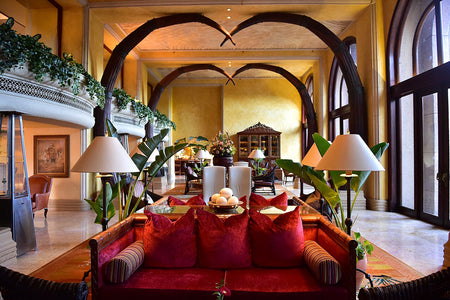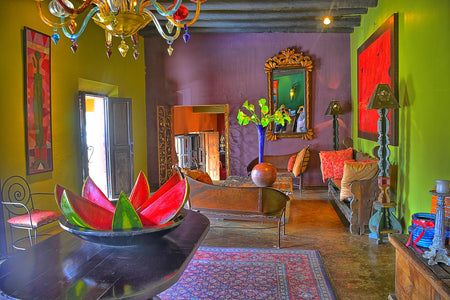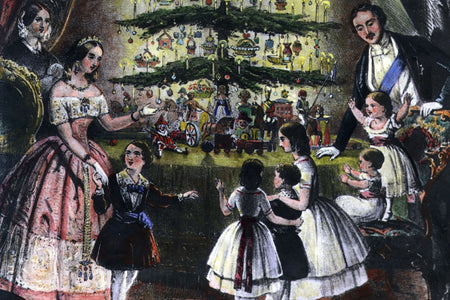
Nothing says glamour quite like a shimmering chandelier. Here’s everything you need to know about the glitziest, showiest form of lighting...
We could have called this post Puttin’ on the Ritz. After all, when it comes to lighting, what sets the pulses racing more than a fabulous crystal chandelier? There is, however, more to the chandelier than you might think. Its original versions were remarkably simple but, over the centuries, the chandelier became increasingly ornate and more varied in style. It even has its own terminology. Bobèche, anyone? We’ll take you back to the earliest days of the chandelier and then trace its long journey to the modern day, with chandeliers to suit every interior and every taste. We are rather proud of Pooky’s own chandelier range so we are also featuring some of our particular favourites.

Chandeliers light up afternoon tea at the Ritz, London. Image credit.
Chandeliers and pendants - what's the difference?
So what exactly is a chandelier and what is the difference between a chandelier and a pendant? A traditional chandelier consists of multiple lamps fixed to or hanging from branched frames; a pendant consists of just one or two lamps hanging from a single cord. And while a chandelier can be as ornate as you like, pendant lighting tends to be simpler.

A mediaeval chandler in his chandlery
Although chandeliers had been around for several centuries, the name chandelier did not appear in the English language until the mid 1700s, derived from the French chandelle (candle), which in turn comes from the Latin, candela. The word chandler comes from the same source: a chandlery was originally the office responsible for wax and candles in a well-to-do mediaeval household. It was also the room in which the candles were kept, presided over by – a chandler.
Chandeliers – first appearances

Mediaeval wooden chandelier with candles.
What we now think of as chandeliers had, in fact, been seen in Europe since the Middle Ages. Using candles as the light source, these early European chandeliers were made of wooden frames; positioned as they were under a timber roof, this made them something of a fire hazard…

6th Century Byzantine polycandelion, Walters Art Museum, Maryland.
They had evolved from the candelabra and polycandelion – a Byzantine form of chandelier that held oil lamps. Polycandela and chandeliers continue to be seen to this day in many different places of worship around the world, including synagogues, churches and mosques, representing light in the darkness.
By the 15th century, metal such as bronze or iron, was often used to create a richly decorated frame in the form of a ring or crown. These ornate frames were the work of skilled craftspeople and expensive; their cost meant that only the wealthiest citizens, such as the nobility, senior clergy, or successful merchants could afford to light their homes with chandeliers. The well-heeled also hunted frequently so, not surprisingly, deer antlers were also used to create chandelier frames.

15th century German chandelier, the Metropolitan Museum of Art.
Chandeliers in the 18th century

18th century Neoclassical Italian chandelier
If any century could rightly be called ‘The Age of the Chandelier’, then it must be the 18th; there were so many developments in styles and materials. The early years of the century saw the advent of cast ormolu frames; these had long, curved arms that held many candles. Neoclassical design was in its ascendancy too and its motifs featured frequently in chandeliers of the period, with frames made of cast metals. Wood frames were still in use but these were now carved and gilded.

George III ormolu mounted, cut glass, eight-light chandelier c1785
Thanks to advances in glassmaking, lead crystal could now be produced more cheaply and in larger quantities. People loved the way that lead crystal could scatter candlelight across a room and, from the middle of the 18th century, this new type of cut glass chandelier soared in popularity. It would remain the most sought after type of chandelier for the next 150 years.
Europeans with deep pockets looked to the glassmakers of Bohemia and Venice for their chandeliers, with Bohemian chandeliers having the edge; the light refraction created by their crystal facets and bevels was superb. Meanwhile, across the lagoon from Venice, glassmakers on the island of Murano were creating incredible new styles using soda glass, which was renowned for its clarity. The skill lay in shaping and twisting the glass to perfection. Murano chandeliers, known as ciocca (bouquet of flowers) were – and continue to be - breathtaking combinations of arabesques of flowers, fruit and leaves, with added richness coming from coloured glass.
On a recent research trip to the island, author Tracy Chevalier was spellbound by the skills of its glassmakers, who are still working in the same way. ‘Venice,’ she remarked on Instagram, ‘is a chandelier. All made by Murano glass maestros.’
Chandeliers – powered by 19th century energy

Art Deco chandelier at the Carew Tower, Cincinatti
Despite the ravages of two world wars and tremendous changes in lifestyles, as well as major developments and changing tastes in interior design, chandeliers have more than held their own. Think of all those glorious Art Deco chandeliers in cinemas and ocean liners.

Italian brass and painted sheet metal Stilnovo style chandelier, 1950s. Image credit
While traditional styles have remained popular, the basic structure has been adapted and transformed. In the 1950s and ‘60s, for example, streamlined chandeliers that paid homage to the Space Age, were produced for the Mid Century Modern home. Pooky has its own versions – see below - and today’s chandeliers are available in an extensive range of textures, embellishment, finishes and styles.

Murano glass Rotunda chandelier by Dale Chihuly, V&A Museum, London
Contemporary chandeliers are often more freeform than their predecessors but also extraordinarily complex, like the work of American glass artist, Dale Chihuly. Chihuly’s spectacular Rotunda chandelier (he prefers the term ‘hanging sculpture’), is one of the first sights that greets visitors to London’s V&A Museum. Over eight metres high and made of blue and green Murano glass, it is so heavy that the V&A had to strengthen the ceiling before it could be hung.

Swarovski crystal chandelier, Sultan Qaboos Grand Mosque, Muscat. Image credit.
But our passion for the dazzling traditional crystal chandelier has never died; we still love them and when it comes to making a statement, secular or spiritual, the cut glass version is hard to beat. And, in terms of modern chandeliers, no statement is quite so dramatic, perhaps, as that of the Swarovski crystal chandelier in Oman’s Sultan Qaboos Mosque in Muscat. It weighs eight tons, is eight metres in diameter, and hangs 14 metres from the ceiling; that’s the size of two three-bedroom houses. Its 1,122 halogen lights provide illumination for the sparkling brilliance that comes from 600,000 crystals.
Chandelier style – the Pooky way
We are rather proud of our chandeliers and like to think that there is a chandelier for everyone and every home in our collection. Rest assured, while we do have a couple of whoppers, none weigh anything like eight tons! Here are some of our current favourites.

Let’s start with a classic – our Juliet French teardrop-shaped beaded chandelier, which brings a touch of bling to traditional Parisian bistro chic. Like many chandeliers, it needs the right space, but in the right space, it looks amazing.
If Art Deco is your thing, take a look at two of our chandeliers that feature glass rods set into a brass frame: the two-layer, six-bulb, Loki and, for a smaller space, the single layer, Athena.

We mentioned Mid Century Modern earlier and this is our take on a 20th century design style, the appeal of which that shows no sign of waning. Our six-arm Bow Tie is available in two sizes in black and white; it’s all about the angles and the distinctive shape of the hoods.
It’s not only Murano glassmakers who are inspired by leaves, fruits and flowers; our English Garden chandelier, designed by Matthew Williamson, draws on the natural world. Finished in a gentle grey with six bulbs sprouting from golden roses, all subtly antiqued, it is a sight to behold. Looks great with naked candle bulbs but, if you prefer, dress it with shades. - Unfortunately the English Garden chandelier is no longer available, please take a look at our chandelier collection here.

Finally, our very own showstopper for a starry, starry night: the capulet. We thought long and hard how to make this beautiful chandelier elegant, without tipping over the top. We very deliberately kept the central brass "belt" plain so as to allow all the glass to do the talking. The shape, we feel, is perfect, and the drops and beads of glass make the light sing... A chandelier to bring you lfelong enjoyment.













